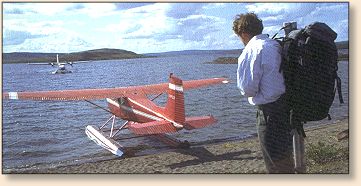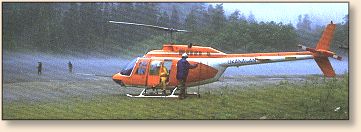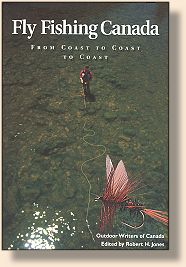Fly-Ins, Part 1
By Dr.Martin Lamont
From Fly Fishing Canada From Coast to Coast, Published
by Johnson Gorman Publishers. We appreciate use permission.
After many hours of pondering over 1:250,000 field
survey maps, I decided on a new destination for a
river fishing trip. Ahh, the best-laid plans...
My route involved many miles of lonely driving along
the dusty Dempster Highway, which was under construction
at the time. After driving as far as I could, it was
evident that I was short of my destination. Although
I could see the remote Peel River valley by the contours
of the land, my optimism faded. Obviously, hiking through
the bush from road's end would be hazardous, with every
possibility of my becoming disoriented. With no
alternative plan, I cursed my bad fortune and wasted
time, then retraced my route along that damned gravel
road.
In those days, my backyard play areas were sparsely
populated northeastern British Columbia, Yukon and the
western Northwest Territories. Although the local fishing
was good, it still necessitated driving long distances.
The logical progression to greater fishing experiences
was to fly in.
Anglers are always seeking adventure in new, unexplored
locations, and Canada's vastness offers some real challenges.
It is 3,400 miles (5,400 km) from the Atlantic coast to
the Pacific, and if a latitude line were drawn at a
northerly 55°, there are approximately 2.7 million
square miles (7 million square km) filled with fish above
and beyond any roads.
Considering that the majority of Canada's angling population
lives close to the 49th parallel, thoughts of northern
fly-in fishing trips are compelling; however, in some
cases the prospect of visiting a remote lodge may seem
intimidating. Ontario, for example has some 2 million
waterways in the form of creeks, rivers, ponds, lake
and inland freshwater seas. Where does one start?
 It should not be surprising that world-class fly-fishing
locations in Canada have been "discovered" by countless
adventurous explorers. Many now operate air charters,
lodges and wilderness camps, and there are lots of
knowledgeable people in those groups who are willing
to help you plan a successful trip.
It should not be surprising that world-class fly-fishing
locations in Canada have been "discovered" by countless
adventurous explorers. Many now operate air charters,
lodges and wilderness camps, and there are lots of
knowledgeable people in those groups who are willing
to help you plan a successful trip.
Maximize your fishing time by contacting the tourism
office in the province or territory in which you are
interested and ask specifically for information on
fly-in destinations. Talk to as many sources as
possible, asking where to catch the fish you seek,
the best times to go, how to get there, what special
equipment is required and the costs.
Timing is critical. Some areas cater heavily to hunting,
so air charters are pre-booked each year with hunters,
guides and outfitters. In such cases, charter services
prefer accommodating anglers at either end of the hunting
season.
Fly-ins require lots of preparation and a firmly
committed group of fellow fly fishers. All should
be willing to contribute their fair share of determining
what is required by way of transportation, maps, camping
equipment, food supplies, boats, motors, fuel, canoes - all
of which may take months to organize.
There is effort and cost in planning an extended stay or
extensive overland or river trip, so your group should
have flexible time frame, say more than two weeks.
Consider hiring a large aircraft; in the long run it may
prove more economical. Small aircraft may carry only one
canoe strapped to its pontoons, and its limited internal
cargo space also affects a party's size. A slightly
larger, twin-engine plane may carry up to three canoes
and all of the camping equipment for six anglers.
Thus, splitting the costs six ways makes sense.
If the destination is remote, the pilot must be familiar
with important details like whether the water is deep
enough to land safely and whether one can beach on a
gravel or sandbar for easy unloading and loading.
Equally important the pickup area should be
predetermined and plans made for an alternative
pickup location if necessary.
Canadian aviation history is closely linked to the
development of northern communities. Anglers, lodge
owners and outfitters owe much to the bush pilots who
flew floatplanes like the classic de Havilland Beavers,
single and twin engine de Havilland Otters. More common
these days are Cessna 185 and 206, and Bell Jet Ranger
helicopters. Although some lodges and logging or mining
camps have remote dirt landing strips, there is far more
need for floatplanes.

For extended trips, choose your fishing companions with
care. Some should have wilderness experience, so their
skills can be used to help out. Otherwise, consider
hiring an experienced camp boss.
Inform several people of your intended destination,
the expected length of time you intend to be there
and your return date. The Royal Canadian Mounted
Police (RCMP) can provide a Wilderness Trip
Registration form to officially record your plans.

While summer tent camping on the tundra near the outlet
of Kathawachaga Lake in the Northwest Territories (NWT),
I set out early one morning to fish by boat. Passing
a nearby island, I spotted a large group of people
vigorously waving at me. I went ashore and discovered
they were canoeing down the Burnside River to Bathurst
Inlet, which was still three day's travel. After
battling constant strong headwinds on the open waters
of Contwoyto Lake, they were behind schedule and had
run out of food. This sorry group had put up camp the
night before, unaware of my presence. They were invited
to my camp and soon revived by a large breakfast.
Reluctantly, they continued their journey later that
day, but fully provisioned from my supplies.
Continued Next Time
Credits: Excerpt from Fly Fishing
Canada written by Outdoor Writers of Canada,
edited by Robert H. Jones, Published by Johnson
Gorman Publishers. Used with permission.
Our Man In Canada Archives
|



